There are so many myths and housewives’ stories when it comes to gardening. Old folks would say that you can use copper nails to kill a tree in a very sneaky way. There has been a lot of debate about it, but how true and effective can copper nails be in killing trees?
Is it just a marketing stunt of copper nails producers, or there is some science behind it?
In this post, we gathered all the resources that we could find to validate the efficiency of using copper nails to kill a tree. We also added other options in responsibly killing trees.
Killing trees just for the sake of killing them is bad for the environment. However, trees growing in the wrong locations can cause problems, such as:
- Bird-flown seeds of trees that grow right next to the foundation of houses
- Tall trees that can damage the power lines
- Trees with invasive roots that can damage concrete
- Clearing a location to plant other types of plants and crops
- Trees that cause boundary problems in residential areas
- Hazard-causing trees that may fall on houses during hurricanes and storms.
In some cases, hammering copper nails to kill a tree is a sneaky act that is often considered as a solution by an angry neighbor.
If that is your case, we highly recommend that you talk to your neighbor and spare the poor innocent tree. Consider finding a common ground or compromise to reach a mutual agreement.
Note: We do not encourage killing trees for recreational purposes.
Q: Do Copper Nails Kill Trees?
No. It is a myth for mature trees but may work on very young trees with 1 to 3-inch diameters. In short, it depends. According to Prof. Nicholas Lepp of Liverpool John Moores University, high-concentration of dissolved copper can kill trees as long as they reach the shoots and roots.
With that, a few copper nails are not enough to kill a healthy and mature tree. There is also no scientific evidence that proves it can work. To successfully kill a mature tree with copper, you have to ensure two things, which are hard to achieve without thorough experimentation:
- A high concentration of dissolved copper matches the size of the tree.
- The copper should reach the roots and the shoots.
You can hammer more nails to a tree to build high concentrations of copper just to prove that it works. However, that would be more labor-intensive, take a long time to work (years), and be more costly than other methods.
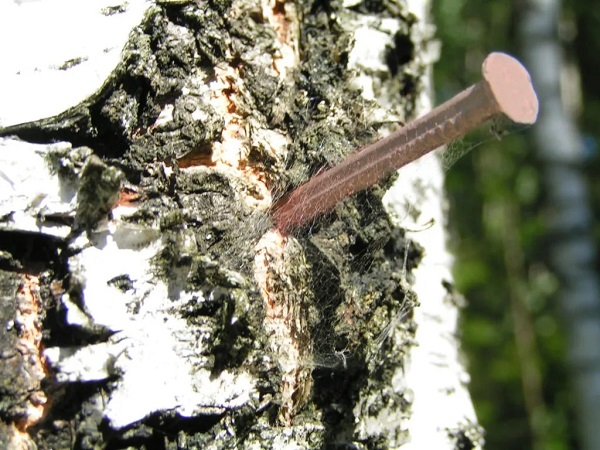
In most cases, people who try to use copper nails to kill mature and healthy trees found their copper nails swallowed by the tree. Some people are encouraged to believe this myth is probably due to other factors that caused the tree to die and not because of the copper nails. Kate Marshall, NZ Gardener’s fruit tree columnist shares the following possible causes:
- Puncture wounds due to the copper nails can invite pest infestation that kills the tree.
- Spores of a fungal disease may get to the puncture wounds and spread throughout the tree.
Copper, in moderate amounts, is a beneficial nutrient for plant or tree growth. Its toxicity happens when it comes in high concentrations. Too much copper can inhibit cell growth and limit the iron intake of plants and trees. It causes oxidative stress on the plants, which can impair photosynthesis.
Therefore, using copper nails to kill trees is a myth. It may work for very young trees with a few inches diameter and other woody plants. To kill mature trees, you have to consider other options.
What Other Methods Can Kill Trees?
We hope that the studies and professional take of the experts helped you rest your case towards the copper nails method. It is better to spend your money on something that works than trying something that has a questionable success in killing trees.
So, we listed some of the tried & tested options that can kill a tree. However, before that, you must learn the types of trees that need treatment to die and those that die just by cutting them:
Trees That Die By Cutting Them Down
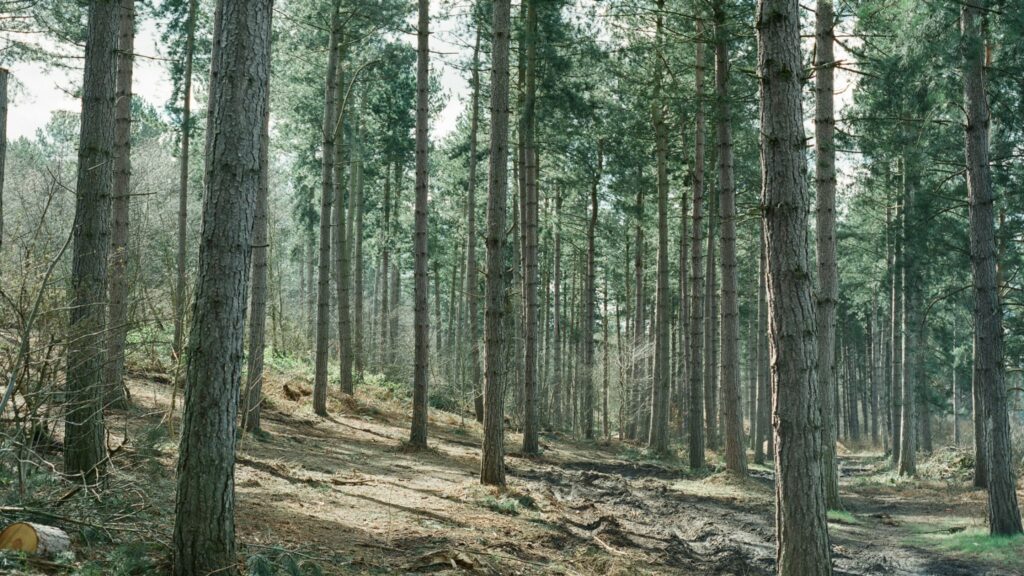
Not all trees need some treatments to die. Some trees immediately die after being cut.
Knowing these types of trees before treating them will save your time, resources, and effort in the long run. The trees that no longer regrow after being cut are:
- Pine trees
- Palm trees
- Oaktree
- Maple trees
- Cedar trees
- Fir trees
- Cypress trees
- Aspen trees
Trees That Need Treatments To Kill
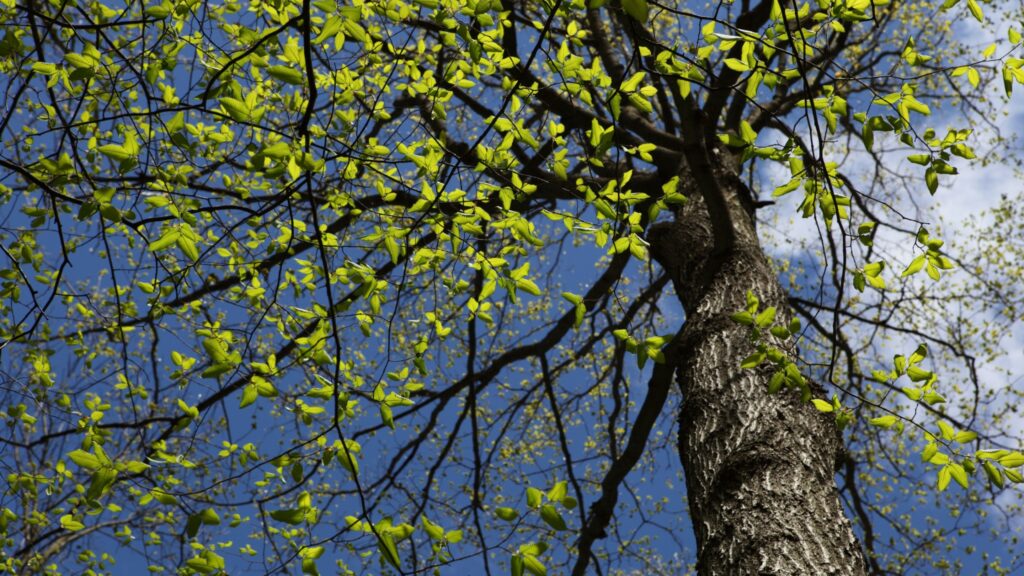
Some types of trees are resilient no matter how you cut them. They are tough to control and grow more suckers or young seedlings around their stumps after a few weeks of being cut. The trees that need treatment to kill are:
- Elm trees
- Cottonwood trees
- Poplar trees
- Willow trees
- Horse apple or hedge apple trees
- Mulberry trees
- Russian olive trees
- Tree of heaven
- Dogwood trees
- Ficus trees
- Neem trees
- Tamarisk trees
7 Methods That Will Surely Kill A Tree
Here are some chemical methods that can kill trees and prevent the tree stumps from regrowing:
Tordon
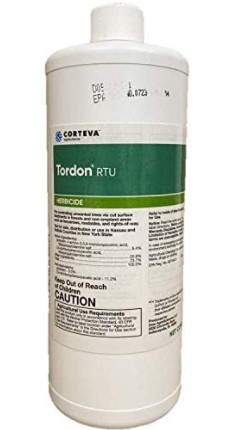
Tordon herbicide is one sure way to kill trees. It is a potent synthetic herbicide that contains Arborists use it to kill persistent and resilient trees like elm trees to clear an area for legal purposes. You only need 1 millimeter of this solution to kill a tree.
Tordon is only commercially available in small amounts because it is regulated by the government. Using too much Tordon or buying higher than what is available in the market can be an offense or may require some permits from your local government.
Hack & Squirt Method
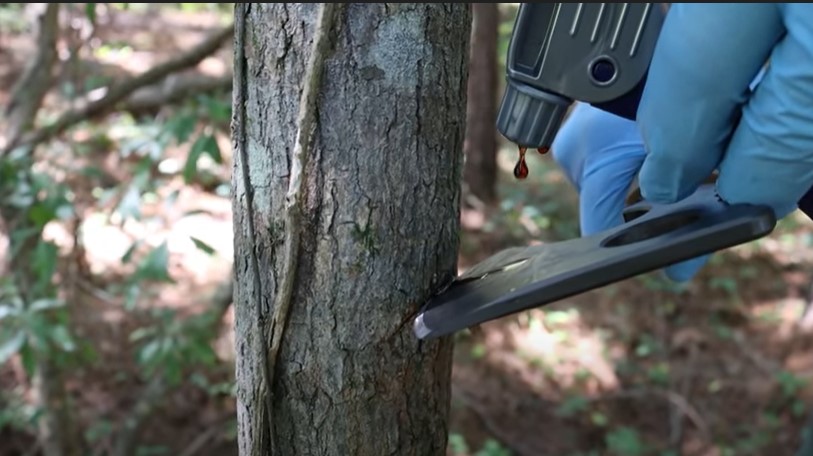
Aside from Tordon, the hack and squirt method is another practice most professionals use to kill trees. Some conditions apply to make this method work. These include:
- Proper timing: Seasons when the sap is low on trees (winter and fall)
- Location: Base of the tree
- Perfect chemical concoction: Follow the recommended ingredients
The hacking opens up the cambium, where nutrients, sap, and water flows throughout the tree. Then, squirting a chemical concoction that will kill the tree.
The advantage of using this method is it allows the tree to keep standing and serve as a nesting spot for birds. You may also use the deadwood as firewood. It’s a slow but sure method in killing trees that take about a year to let the trees die on their own.
Note: make sure to avoid smoking or starting a bonfire near treated trees to prevent wildfire.
Here’s how you can make the solution for the hack and squirt method:
Materials:
- 1 Hatchet or axe
- Spray or squirt bottle (recycle any ketchup bottle or sriracha bottle)
- ½ quart of kerosene
- ½ quart of Triclopyr
- 1 tbsp. Methylated seed oil
- A few drops of red dye for markings
Directions:
- Mix the kerosene, Triclopyr, Methylated seed oil, and red dye. Transfer an adequate amount on a spray or squirt bottle.
- Hack the tree base just at the height of your legs and squirt it with the solution. The red dye will be your guide for the ones that you have treated.
- Wait for a year to check the tree condition that you treated. You’ll know that it’s dead when its color changes and mushrooms grow on it.
Girdling
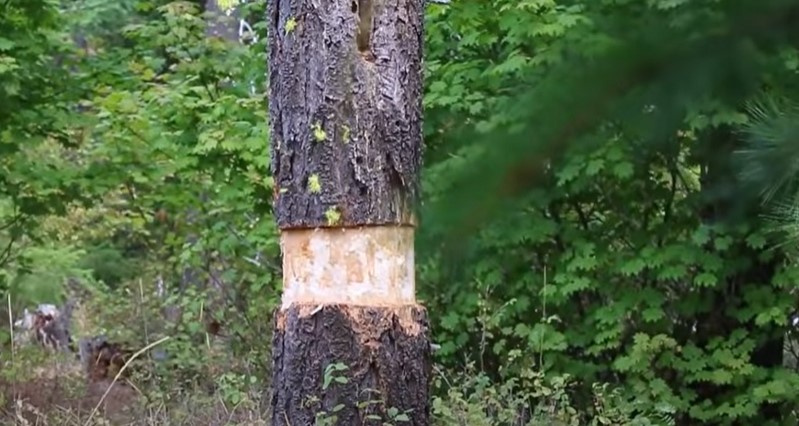
Girdling is a traditional way of killing trees by cutting through the bark and cambium of the tree to stop the supply of nutrients and water and let it slowly die. Once the tree is dead, it dries up while still standing, which provides the perfect firewood.
A dried and dead tree would usually fall over on its own when struck with violent winds. Here’s how you can start girdling a tree on your own:
Materials:
- Chainsaw or crosscut saw
- Rope or marking tape
- Axe
Directions:
(1) Marking the girdle

(2) Use the ax to remove the bark and cambium in between the markings. Make sure that you remove the cambium well.
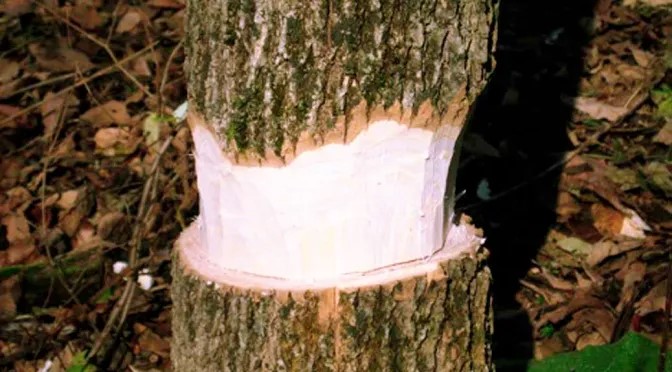
(3) Tie a rope or tree marking tape around the tree. It will serve as a signal for people around to stay away from it.
RoundUp Concoction
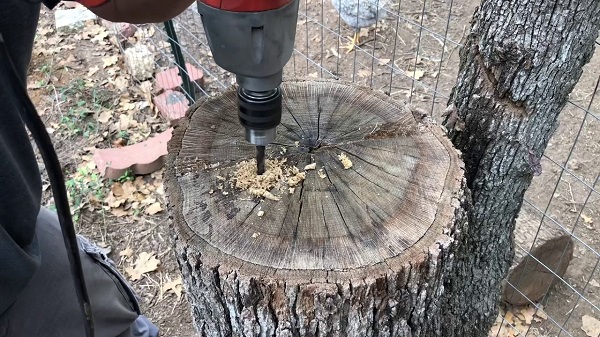
If you want to remove the tree stump of trees that keep re-growing, you can use glyphosate. However, glyphosate alone will not kill and rot a tree stump. Here’s how:
Materials:
- Drill
- 3 tbsp. of Glyphosate (RoundUp)
- 3 tbsp. of Hi-Yield Spreader Sticker
- 1 tbsp. of Hi-Yield Ammonium Sulfate
Directions:
- In a bucket, mix glyphosate, spreader sticker, and ammonium sulfate. Transfer an adequate amount in a squirter or your recycled ketchup bottle.
- Drill holes on the tree stump.
- Pour the solution into the holes in the stump, and leave it to work on the stump. After a few weeks, check the stump, and you will notice that it’s dry and starts decomposing. Mushrooms may also grow on it.
Epsom Salt
Another option efficient in killing trees in their tree stump form is using Epsom salt. It is an inexpensive solution wherein you place the Epsom salt close to the tree roots or on the drilled holes on the stump. Epsom salt will absorb the moisture and dry out the tree.
Large trees will require a lot of Epsom salt to make it work. Otherwise, you will end up ruining the soil within achieving your goal.
Gordon’s Stump Killer
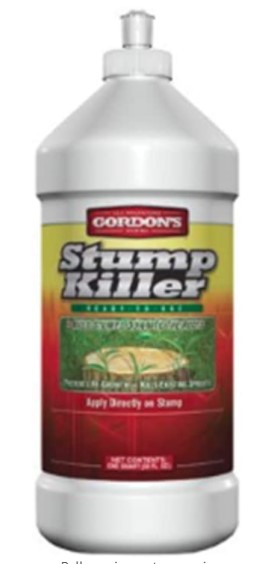
Gordon’s Stump Killer is another undiscovered gem that can efficiently kill trees. It is a very potent option that you can use as a last resort in killing a tree. In some cases, one application can kill a trail-long number of trees. It also contains glyphosate, which makes it an ideal alternative for RoundUp.
Note: Use this herbicide on non-windy days and when rain is not forecasted.
Compost
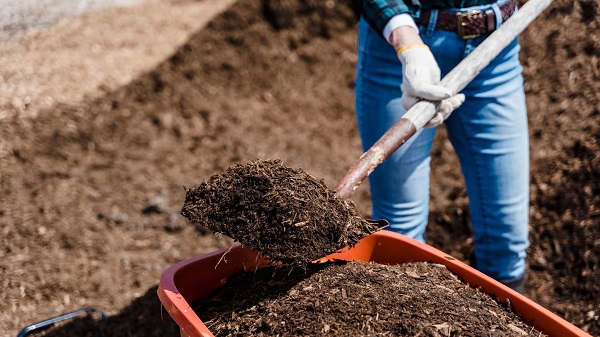
If you’re not too impatient, you may also let nature take its course in killing a tree. You can prevent the tree from re-growing by placing your compost in the location of the live stump.
The bacteria in the compost will naturally kill the tree and decompose it over time. Composting a live tree stump is an ideal option if you don’t want to use any chemicals in removing or killing the tree. However, it can take years before the tree decomposes completely.
Final Thoughts
We hope that this post helped answer your questions about the truth behind the use of copper nails to kill trees. It is a myth that continues to confuse a lot of novice gardeners. So, the next time you hear about it, make sure to set things right and share this post.
With many opinions between gardeners all over the Internet, it pays to get the best advice from experts and evidence from studies. Doing so will not only save you from buying the wrong things. It also keeps you from wasting your time and effort waiting for nothing.
Let us know in the comments section which tree-killing method worked for you. Do you use a secret technique to kill unwanted trees? Please share it in the comments section below so more gardeners can learn from your experience.
Before ending this post, we would like to clarify that we do not condone killing trees because without them our planet will die. We only support killing unwanted trees that pose danger to homeowners and hinder other wanted plants and trees from growing.
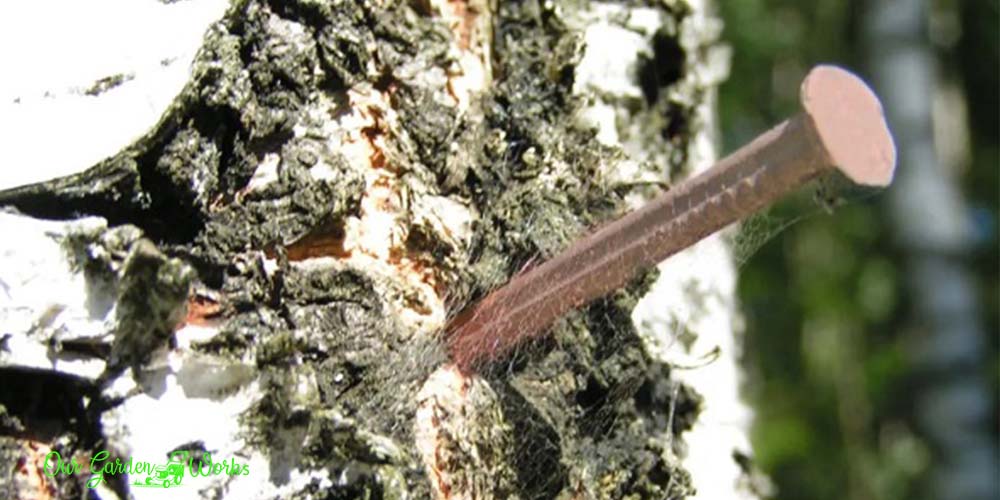
“Tordon herbicide is one sure way to kill trees. It is a potent synthetic herbicide that contains Arborists use it to kill persistent and resilient trees like elm trees to clear an area for legal purposes. You only need 1 millimeter of this solution to kill a tree.” <==== "1 millimeter" <==== This is meaningless.